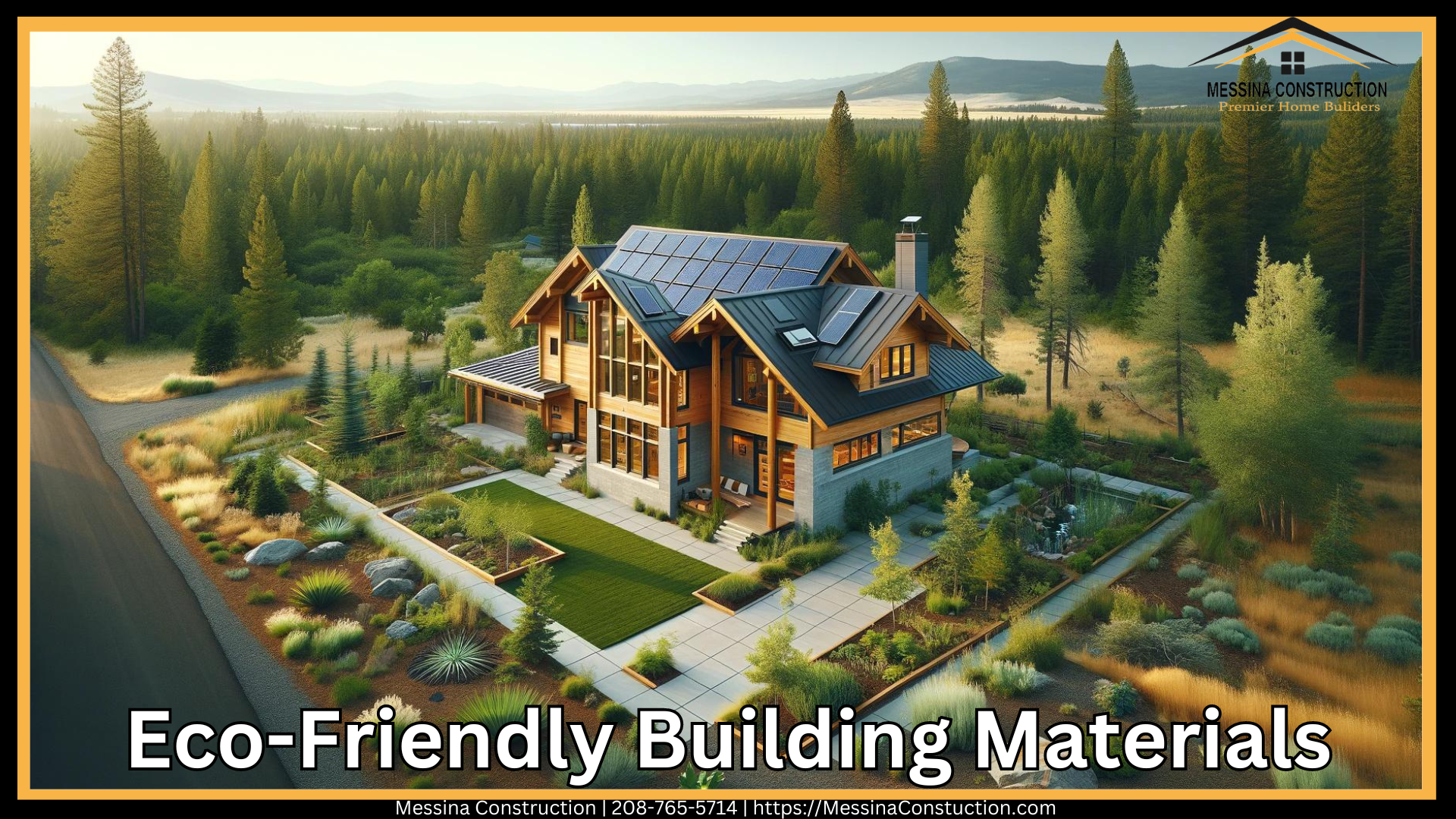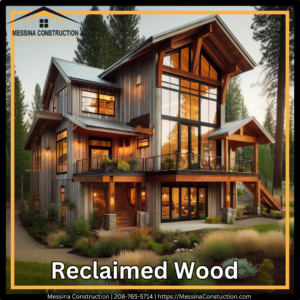Eco-Friendly Building Materials
The construction industry is stepping up to the sustainability challenge in today’s rapidly changing world. At Messina Construction, we’re committed to integrating eco-friendly building materials and practices into every project. This guide will explore the best sustainable options in 2024, ensuring your next build is environmentally friendly and cutting-edge.
Table of Contents
Why Choose Eco-Friendly Building Materials?
Eco-friendly building materials are designed to reduce the environmental impact of construction. They help conserve resources, minimize waste, and often result in healthier buildings for occupants. By choosing sustainable materials and practices, Messina Construction helps protect our planet and delivers long-term cost savings and increased building efficiency.

The allure of natural materials in kitchens and baths speaks to a desire for authenticity and connection to the natural world. The trend towards wood, stone, and metal in 2024 is about creating grounded, inviting, and enduring spaces. This kitchen and bath trend is taking off like wildfire.
Top 5 Eco-Friendly Building Materials
-
Recycled Steel
Recycled steel is an outstanding eco-friendly building material known for its incredible strength and versatility. Unlike traditional steel, recycled steel requires significantly less energy to produce. This reduction in energy usage translates to a smaller carbon footprint.
Recycled steel is ideal for structural applications, such as beams and columns, and can also be used in roofing and siding. One of its main benefits is its durability; steel does not warp, crack, or expand, ensuring long-term structural integrity. Furthermore, recycling steel helps divert waste from landfills, promoting a circular economy.
-
Bamboo
Bamboo is rapidly gaining popularity as a sustainable building material. It’s one of the fastest-growing plants in the world, capable of reaching maturity in three to five years, compared to the decades it takes for traditional hardwoods. This rapid growth rate makes bamboo a highly renewable resource.
Bamboo’s strength rivals steel’s in tension, and its lightweight nature makes it easy to transport and handle on-site. It’s used in various applications, from flooring and cabinetry to structural elements and decorative accents. Bamboo cultivation has a low environmental impact, requiring minimal pesticides and fertilizers.
-
Insulated Concrete Forms (ICFs)
Insulated Concrete Forms (ICFs) are revolutionizing how we think about building insulation. These forms are made from expanded polystyrene (EPS) or other foam materials and are used as hollow blocks stacked to create the building’s walls. Once in place, concrete is poured into the forms, creating a solid, insulated structure.
ICFs offer several benefits. They provide excellent thermal insulation, reducing heating and cooling costs by maintaining a stable indoor temperature. They also enhance the building’s structural strength and fire resistance. ICFs are particularly advantageous in regions prone to extreme weather conditions, as they can withstand high winds and seismic activity. Additionally, the forms are lightweight, making them easy to handle and install, thus reducing construction time and labor costs.
-
 Reclaimed Wood
Reclaimed Wood
Reclaimed wood is an environmentally responsible choice and adds unique character and charm to any building project. Sourced from old barns, factories, warehouses, and other structures, reclaimed wood often features distinctive marks, knots, and patina that tell a story of its previous life.
Using reclaimed wood reduces the demand for new timber, conserving forests and reducing deforestation. It’s typically used in flooring, wall paneling, beams, and furniture. Moreover, reclaimed wood is often of higher quality than newly harvested wood, as it comes from mature trees cut decades or centuries ago. This mature wood is denser and more durable, making it a long-lasting option for construction.
-
Low-E Windows
Low-emissivity (Low-E) windows are designed to enhance a building’s energy efficiency by minimizing the amount of ultraviolet and infrared light that passes through the glass without compromising the amount of visible light transmitted. These windows have a special coating that reflects heat, keeping interiors cooler in the summer and warmer in the winter.
Installing Low-E windows can significantly reduce heating and cooling costs, contributing to a building’s energy efficiency. They also help protect furnishings and flooring from fading due to UV exposure. Low-E windows are available in various styles and can be customized to fit any architectural design, making them a versatile and practical choice for residential and commercial buildings.
Incorporating these eco-friendly building materials into your next project can create a more sustainable, efficient, and aesthetically pleasing structure. Messina Construction is dedicated to helping you choose the best materials to meet your environmental goals and design vision.
6 Best Eco-Friendly Building Practices
-
Passive Solar Design
 Passive solar design harnesses the sun’s energy to heat naturally and light buildings, reducing reliance on mechanical systems. This practice strategically places windows, walls, and floors to collect, store, and distribute solar energy.
Passive solar design harnesses the sun’s energy to heat naturally and light buildings, reducing reliance on mechanical systems. This practice strategically places windows, walls, and floors to collect, store, and distribute solar energy.
Key elements include south-facing windows, thermal mass materials like concrete or stone that absorb and store heat, and overhangs or shading devices to prevent overheating in the summer. By leveraging natural sunlight, passive solar design can significantly reduce energy consumption, lower utility bills, and improve indoor comfort. Messina Construction integrates passive solar principles into our projects, ensuring optimal energy efficiency.
-
Green Roofing
Green roofs, also known as living roofs, are covered with vegetation. They offer multiple environmental benefits, such as reducing urban heat island effects, improving air quality, and providing natural insulation. Green roofs help manage stormwater runoff by absorbing rainwater, reducing the burden on drainage systems.
There are two main types of green roofs: intensive and extensive. Intensive green roofs have deeper soil and can support various plants, including trees and shrubs. Extensive green roofs have shallower soil and support low-maintenance vegetation like grasses and sedums. Messina Construction can design and install green roofs tailored to your building’s needs, enhancing aesthetics and sustainability.
-
Water Conservation Systems
Water conservation systems are essential for reducing water usage and promoting sustainability. Two primary systems include rainwater harvesting and greywater recycling.
- Rainwater Harvesting: This system collects and stores rainwater from roofs and other surfaces for non-potable uses like irrigation, toilet flushing, and laundry. Rainwater harvesting reduces demand for municipal water supplies and can lower water bills.
- Greywater Recycling: Greywater systems recycle wastewater from sinks, showers, and washing machines. After treatment, greywater can be reused for irrigation and flushing toilets. This practice reduces the amount of freshwater needed for daily activities and decreases the volume of wastewater entering the sewage system.
Messina Construction incorporates these systems into our projects, ensuring efficient water use and conservation.
-
Energy-Efficient HVAC Systems
Heating, ventilation, and air conditioning (HVAC) systems are crucial for maintaining indoor comfort. However, traditional systems can be energy-intensive and environmentally damaging. Upgrading to energy-efficient HVAC systems can significantly reduce a building’s carbon footprint.
High-efficiency HVAC systems have higher SEER (Seasonal Energy Efficiency Ratio) ratings, meaning they use less energy to produce the same cooling or heating. Additionally, smart thermostats and zoning systems allow precise control over different areas of a building, optimizing energy use.
Messina Construction recommends and installs advanced HVAC systems that enhance energy efficiency, lower operating costs, and improve indoor air quality.
-
Sustainable Landscaping
Sustainable landscaping practices create eco-friendly outdoor spaces that complement the building’s environmental goals. These practices include using native plants, xeriscaping, and organic fertilizers.
- Native Plants: Native plants are adapted to local climate and soil conditions, requiring less water, fertilizers, and pesticides. They support local wildlife and promote biodiversity.
- Xeriscaping: This landscaping method focuses on water conservation through drought-tolerant plants, efficient irrigation, and mulching. Xeriscaping reduces water usage and maintenance needs.
- Organic Fertilizers: Organic fertilizers and compost enrich the soil naturally, improving plant health without harmful chemicals.
Messina Construction integrates sustainable landscaping into our projects, enhancing beauty while promoting ecological balance.
Smart home technology plays a pivotal role in creating energy-efficient and sustainable buildings. These technologies include automated lighting, smart thermostats, and energy monitoring systems.
- Automated Lighting: Smart lighting systems use sensors and timers to control lighting based on occupancy and natural light levels, reducing energy consumption.
- Smart Thermostats: These devices learn your preferences and adjust heating and cooling accordingly, optimizing energy use. They can be controlled remotely, allowing for efficient energy management.
- Energy Monitoring Systems: These systems provide real-time data on energy usage, helping identify areas for improvement and ensuring optimal efficiency.
Messina Construction incorporates smart home technology into our projects, enabling clients to manage their energy use effectively and sustainably.
By adopting these eco-friendly building practices, Messina Construction ensures that each project meets current environmental standards and sets new benchmarks for sustainability and efficiency. Let’s work together to create buildings that are good for the planet and great for your bottom line.
Conclusion
Building sustainably is no longer a choice but a necessity. By incorporating eco-friendly materials and practices, Messina Construction ensures your projects are ahead of the curve, benefiting both the environment and your bottom line. The options are vast and impactful from recycled steel to smart home technology. Let’s build a greener future together!
FAQs
What are the benefits of using eco-friendly building materials?
Eco-friendly building materials reduce environmental impact, lower energy costs, and often result in healthier indoor environments.
How does Messina Construction integrate sustainability into its projects?
Messina Construction uses various sustainable materials and practices, such as recycled steel, bamboo, green roofing, and energy-efficient HVAC systems.
Can sustainable building practices save money?
Sustainable practices often result in long-term savings through reduced energy and water consumption, lower maintenance costs, and increased building efficiency.
Are eco-friendly materials as durable as traditional ones?
Many eco-friendly materials, like recycled steel and bamboo, are as durable, if not more so, than their traditional counterparts.
What is passive solar design?
Passive solar design strategically places windows, walls, and floors to naturally heat and light a building, reducing the need for mechanical systems.
